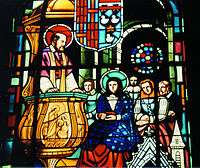Jane Frances de Chantal
Saint Jane Frances de Chantal (Jeanne-Françoise Frémiot, Baronne de Chantal) (28 January 1572 – 13 December 1641) is a Roman Catholic saint, who was beatified in 1751 and canonized in 1767.[1] She founded the religious Order of the Visitation of Holy Mary.[2][3] The order accepted women who were rejected by other orders because of poor health or age. When people criticized her, Chantal famously said, "What do you want me to do? I like sick people myself; I'm on their side." During its first eight years, the new order also was unusual in its public outreach, in contrast to most female religious who remained cloistered and adopted strict ascetic practices.
Jane Frances de Chantal | |
|---|---|
 | |
| Foundress | |
| Born | 28 January 1572 Dijon, Burgundy, France |
| Died | 13 December 1641 (aged 69) Moulins, France |
| Venerated in | Roman Catholic Church |
| Beatified | 21 November 1751, Rome by Pope Benedict XIV |
| Canonized | 16 July 1767, Rome by Pope Clement XIII |
| Major shrine | Annecy, Savoy |
| Feast | 12 August 21 August (General Roman Calendar 1769-1969) 12 December (General Roman Calendar 1970-2001) |
| Patronage | forgotten people; in-law problems; loss of parents; parents separated from children; widows |
Life
Jane Frances de Chantal was born in Dijon, France, on 28 January 1572, the daughter of the royalist president of the Parliament of Burgundy. Her mother died when Jane was 18 months old. Her father became the main influence on her education. She developed into a woman of beauty and refinement, lively and cheerful in temperament.[4] She married the Baron de Chantal when she was 21 and then lived in the feudal castle of Bourbilly. Baron de Chantal was accidentally killed by an arquebus while out shooting in 1601. Left a widow at 28, with four children, the broken-hearted baroness took a vow of chastity. Her mother, stepmother, sister, first two children, and now her husband had died.[5] Chantal gained a reputation as an excellent manager of the estates of her husband, as well as of her difficult father-in-law, while also providing alms and nursing care to needy neighbors.
The pious baroness could not bring herself to forgive the individual who had accidentally caused her husband's death, until in 1604 she heard a Lenten sermon of the bishop of Geneva Francis de Sales, who preached on the subject of the love of God at the Sainte Chapelle in Dijon.[1] They became close friends and de Sales became her spiritual director. She wanted to become a nun but he persuaded her to defer this decision.[4] Later, with his support, and that of her father and brother (the archbishop of Bourges), and after providing for her children, Chantal left for Annecy, to start the Congregation of the Visitation. The Congregation of the Visitation was canonically established at Annecy on Trinity Sunday, 6 June 1610.[5] The order accepted women who were rejected by other orders because of poor health or age. During its first eight years, the new order also was unusual in its public outreach, in contrast to most female religious who remained cloistered and adopted strict ascetic practices. The usual opposition to women in active ministry arose and Francis de Sales was obliged to make it a cloistered community following the Rule of St. Augustine. He wrote his Treatise on the Love of God for them.[4] When people criticized her for accepting women of poor health and old age, Chantal famously said, "What do you want me to do? I like sick people myself; I'm on their side."[6]
Her reputation for sanctity and sound management resulted in many visits by (and donations from) aristocratic women. The order had 13 houses by the time de Sales died, and 86 before Chantal herself died at the Visitation Convent in Moulins, aged 69. St. Vincent de Paul served as her spiritual director after de Sales' death. Her favorite devotions involved the Sacred Heart of Jesus and the Heart of Mary.[7] Chantal was buried in the Annecy convent next to de Sales.[5] The order had 164 houses by 1767, when she was canonized. Chantal outlived her son (who died fighting Huguenots and English on the Île de Ré during the century's religious wars) and two of her three daughters, but left extensive correspondence. Her granddaughter also became a famous writer, Marie de Rabutin-Chantal, marquise de Sévigné.
Veneration

She was beatified on 21 November 1751 by Pope Benedict XIV, and canonized on 16 July 1767 by Pope Clement XIII.[1]
Saint Jane Frances's feast day was included in the General Roman Calendar in 1769, two years after she was canonized. Her feast was set as 21 August. In the 1969 revision of the calendar, her feast was moved to 12 December, to be closer to the day of her death, which occurred on 13 December 1641, the feast of St. Lucy.[8] In 2001, Pope John Paul II included in the General Roman Calendar the memorial of Our Lady of Guadalupe on 12 December.[9] Consequently, he moved the memorial of Saint Jane Frances to 12 August.[10]
Patronage
St. Jane Frances de Chantal is invoked as the patron of forgotten people, widows, and parents who are separated from their children.[1]
Writings of Saint Jane Frances

Saint Jane Frances de Chantal wrote some exemplary letters of spiritual direction.[11]
See also
- Saint Jane Frances de Chantal, patron saint archive
References
- "Jane Frances de Chantal", Saints Resources, RCL Benziger
- "St Jane Frances de Chantal: a saint to inspire women keen to enter religious life". Catholic Herald. Retrieved 2018-08-13.
- "St. Jane Frances de Chantal". Catholic Online. Retrieved 2018-08-13.
Jane founded the Visitation order for women who were rejected by other orders because of poor health or age.
- Foley O.F.M., Leonard. "St. Jane Frances de Chantal", Saint of the Day, Lives, Lessons and Feast Archived 2005-04-22 at the Library of Congress Web Archives, (revised by Pat McCloskey O.F.M.), Franciscan Media
- Pernin, Raphael (1910). St. Jane Frances de Chantal. 8. New York: Robert Appleton Company: The Catholic Encyclopedia. Retrieved 2 February 2013.
- http://www.thebestcatholic.com/2016/08/12/saint-jane-frances-de-chantal/ Saint Jane Frances de Chantal
- "Santa Juana Chantal". Piercedhearts.org. Retrieved 2017-04-01.
- Calendarium Romanum (Libreria Editrice Vaticana 1969), p. 110
- Decree 2492/01/L of 18 December 2001 of the Congregation for Divine Worship and the Discipline of the Sacraments
- "Newsletter of the USCCB Committee on Divine Worship" (PDF). Usccb.org. May 2009. p. 24.
- Francis de Sales, Jane de Chantal, Letters of Spiritual Direction (Classics of Western Spirituality); translated by Péronne Marie Thibert, V.H.M. Mahwah, NJ: Paulist Press, 1988.
Bibliography
- Saint Jeanne-Françoise de Chantal (1988). Francis de Sales, Jane de Chantal: Letters of Spiritual Direction. Paulist Press. ISBN 978-0-8091-2990-4.
External links
| Wikimedia Commons has media related to Jane Frances de Chantal. |
- St. Jane Frances de Chantal at Catholic Online
- Saint Jeanne de Chantal at Patron Saints Index
- Saint Jane Frances De Chantal School in North Hollywood, California
- Works by Jane Frances de Chantal at Project Gutenberg
- Works by Jane Frances de Chantal at LibriVox (public domain audiobooks)
